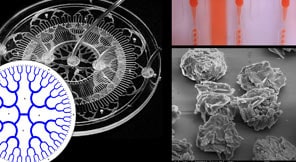Microfluidic System for Mass Production of Emulsions
Design and fabrication of microfluidic devices for emulsion production at high throughput rates

KAUST has developed and fabricated a novel multilayer microfluidic device for the mass production of monodisperse single emulsions. The droplets produced from the device have a mean diameter ranging from 100 to 200 micrometers with the highest throughput rate ever reported for a single chip. The parallelization device is comprised of multiple generation layers with hundreds of flow-focusing microfluidic droplet generators arranged in a parallel polar array. The fabrication process is lowcost and allows to integrate dedicated distribution layers within the chip to eliminate parasitic losses and crosstalk between the generator. The design and fabrication methods are flexible, enabling better control of droplet diameter and throughput.
Possible applications for these microfluidic emulsions are found in industries like pharmaceutical, cosmetics, chemical and nanotechnology.
Technology Summary
The novel multilayer microfluidic device enables the mass production of monodisperse single emulsions. Demonstrated to have the highest throughput for a single device, the device provides control of the droplet size and is completely scalable based on production requirements. The microfluidic system incorporates post-droplet generation processing that can modify the structure and composition in order to produce any kind of engineered particles. The device could be used in the production of highly monodisperse emulsions for a number of different industries.
Why It Is Better
 High-volume parallelization of microfluidic droplet generators has been demonstrated previously for only one layer of generators that require the use of an externally fabricated distribution manifold. This lack of integration limits the scalability of these 2D parallelization systems because the flow distribution over the generators is unbalanced for large areas. The novel three-dimensional parallelization chip designed by KAUST consists of a stack of at least four comprising layers: the bottom layer containing 128 microfluidic droplet generators, a water distribution layer, an oil distribution layer and a cover layer. The generators are connected with the upper layers via through holes. The design is not limited to four layers and more generation layers can be incorporated to stack any number of microfluidic droplet generators for increased scalability.
High-volume parallelization of microfluidic droplet generators has been demonstrated previously for only one layer of generators that require the use of an externally fabricated distribution manifold. This lack of integration limits the scalability of these 2D parallelization systems because the flow distribution over the generators is unbalanced for large areas. The novel three-dimensional parallelization chip designed by KAUST consists of a stack of at least four comprising layers: the bottom layer containing 128 microfluidic droplet generators, a water distribution layer, an oil distribution layer and a cover layer. The generators are connected with the upper layers via through holes. The design is not limited to four layers and more generation layers can be incorporated to stack any number of microfluidic droplet generators for increased scalability.
The design includes thin layers (approximately 1mm), which can keep the system compact. In addition, the distribution lines are produced on dedicated layers for each immiscible liquid and connect with the through holes feeding the generators. The inputs are placed axisymmetrically at the center of the device to produce an even loading of the liquids and to prevent the formation and trapping of air bubbles in the feed lines. This demonstrates the full integration of the distribution network within the chip.
Unlike batch processing, microfluidic reactors in the form of emulsions provide better control of reagents, mixing rate, residence time and environmental conditions for the processing of microparticles. In addition, the design could lead to a microfluidic solution that could increase the production of emulsions to an industrially relevant scale in a cost-effective manner.
IP Protection
KAUST has several patents pending for this technology.
Invention Track Code
2013-057

Benefits
- These emulsions can be used as microreactors with better control of reagents, mixing rate, residence time and environmental conditions for the processing of nano/micro particles.
- Fabrication enables the integration of many layers within one chip.
- Scalable for increased throughput rates.

Applications
- Production of highly monodisperse emulsions
- Active pharmaceutical ingredients
- Chemical
- Cosmetics
- Nanoparticles
- Quantum dots
